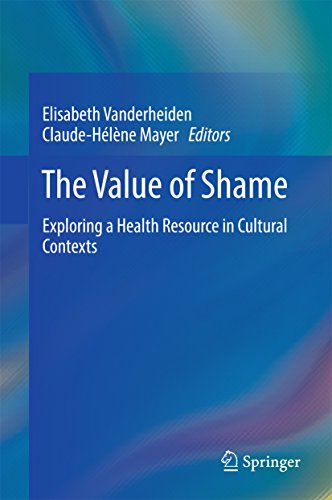
The Value of Shame: Exploring a Health Resource in Cultural Contexts
By Elisabeth Vanderheiden and Claude-Hélène Mayer
Cham, Switzerland: Springer, 2017. 302 pp.
ISBN 978-3-319-53099-4. $119.00
Reviewed by Paul T. P. Wong
The Value of Shame: Exploring a Health Resource in Cultural Contexts is a welcome addition to the growing library on the positive values of negative emotions (Kashdan & Biswas- Diener, 2014; Lomas, 2016; Parrott, 2014). This area of research represents an important new development in positive psychology (PP) because all “emotions are strongly connected to an individual’s health and wellbeing” (p. 3). Moreover, most of the basic emotional reflexes are negative in valence but essential for our survival and wellbeing (Chapter 3 of this book).
The adaptive value of shame has not received much attention from PP researchers. “The aim of this book is to synthesize empirical research-based and theoretical perspectives on shame in various cultural contexts” (p. 2). This volume is exceptional because of its comprehensive and scholarly coverage of the value of shame, from its biological foundation (Chapter 3), developmental roots in infancy (Chapters 2 and 12), and moral and spiritual dimensions (Chapter 4) to cultural contexts (Part I).
All chapters were well written and thoroughly researched. The applications of shame work (the last three chapters) are based on a holistic conception of shame and can be adopted by therapists regardless of their preferred therapeutic modality. For example, all therapists need to learn how to explore their own blind spots of past shame and provide a safe environment to do shame work with their clients.
The multicultural perspectives of this book are very valuable to the advancement of international psychology. For example, shame is more positively valued in Asian cultures because it enhances the ideal of harmony within a collectivistic society. For instance, “Bedford and Hwang (2003) point out that the duty-based morality in Confucian cultures incorporate shame to ensure conformity to the group” (p. 219). Therefore, excessive concerns about “losing face” can be a hindrance for Asians in an individualistic culture.
From my vantage point, this book also contributes to the theoretical development of PP 2.0 (Wong, 2011), also known as the second wave of PP (Ivtzan, Lomas, Hefferon, & Worth, 2015). With shame as a prototype of a universal and ubiquitous negative emotion, this volume supports two essential assumptions of PP 2.0.
All Emotions are Dualistic in Nature, with Healthy and Unhealthy Sides
Every emotion has its upside and downside. PP 2.0 maintains that well-being is based on how we manage the polarities of each emotion to ensure that its experience and expression are appropriate for the person, the relationship, and the cultural norm. Therefore, it would be less adaptive to focus only on positive emotions or experiences and ignore the cancerous elements in one’s life.
Like any emotions, there are things in life that we should be ashamed of just as there are things that we should be rightly afraid of. We should all feel ashamed for getting caught cheating or doing things that are against of our standards of decency. Such “healthy shame with its roots in personal conviction, is inherently associated with values and self-evaluation. Understood thus, it is an integral part of wholesome human functioning in the personal, social, and cultural realms” (p. 87).
Aquinas even goes further and argues that shame “is an emotion that enhances human flourishing, personally and socially” (p. 91). For Aquinas, shame serves as a virtue that helps us grow spiritually; “shame makes one more sensitive to what threatens virtue, personal goodness, and more importantly, what fosters or undermines our responsiveness in relationships” (p. 92).
Shamelessness in doing things that are universally considered shameful may not be a good thing; the absence of shame can be harmful to one’s psychological and spiritual well-being just as the inability to feel pain can be harmful to our physical well-being.
Despite the inherent value of shame, it can be harmful to the development of resilience and flourishing, if one depends too much on avoiding, escaping, and succumbing as coping responses to shame. Furthermore, suppressed memories of shameful events come back to haunt us.
In sum, negative emotions are constructive when they motivate us toward what is good and adaptive but destructive when we choose to withdraw from or suppress them. Each person has the capacity to make the right choice. Thus, the challenge for PP is to discover what kind of belief and values predispose individuals to turn negative emotions to positive outcomes. Another research challenge from the PP 2.0 perspective is to discover how positive and negative emotions complement each other to yield optimal well-being.
Emotions Have Both Intrapsychic and Interpersonal Dark Sides
PP 2.0 emphasizes the importance of embracing the dark side of life. There are both intrapsychic and interpersonal dimensions of the dark side of human existence. In the case of shame, the intrapsychic dark side may include childhood wounding in the hands of a caretaker or a damaged ego due to personal handicaps or failing to live up to expectations.
The interpersonal dark side of existence includes the accumulated toxic experiences of rejection, bullying, marginalization, and isolation. Together with the intrapsychic shadow, the dark side of shame may color our beliefs, perceptions, and feelings, as well as negatively affect our well-being. The emotional burden from the past and the toxic people around you can take away all your human dignity, self-respect, and personal happiness. In some cases, professional help may be needed to confront and embrace the dark side of shame.
In view of the above, I agree with May (Chapter 2) that “positive psychology has something to learn from system psychodynamics about being in the presence of and surviving apparently destructive elements such as shame” (p. 57). Learning how to embrace and live with the dark side is necessary, because the toxic elements of life will not automatically go away simply by choosing to focus on positive emotions and experiences. Rather, facing the dark side with courage may be the only gateway to resilience and flourishing as the book has documented.
Conclusion
All the research findings reported in this book support the contention of PP 2.0 that it is impossible to give a full account of well-being without taking into consideration the toxic elements in one’s personal and social life, just as it is impossible to give a full account of physical health without taking into account the bacteria, viruses, and toxins in the environment.
Mayer (Chapter 12) proposes that “in therapy, though, shadows can be incorporated and used for further self-development by exploring the positive aspect of the experiences, values, and thoughts classified as ‘shadow’ by the client or his/her socio-cultural environment” (p. 282).
The same logic can also be applied in our attempts to address all uncomfortable emotions and situations. The optimal way to enhance people’s well-being individually and collectively is to incorporate and transform the dark side in addition to practicing the traditional PP exercises.
This book shows us how we can transcend the divide between the pathological side and the positive side for shame. That is why I highly recommend this landmark publication to both PP researchers and clinicians.
References
- Ivtzan, I., Lomas, T., Hefferon, K., & Worth, P. (2015). Second wave positive psychology: Embracing the dark side of life. London, UK: Routledge.
- Kashdan, T., & Biswas-Diener, R. (2014). The upside of your dark side: Why being your whole self—Not just your “good” self—Drives success and fulfillment. New York, NY: Plume.
- Lomas, T. (2016). The positive power of negative emotions: How harnessing your darker feelings can help you see a brighter dawn. London, England: Piatkus.
- Parrott, W. G. (Ed.). (2014). The positive side of negative emotions. New York, NY: Guilford.
- Wong, P. T. P. (2011). Positive psychology 2.0: Towards a balanced interactive model of the good life. Canadian Psychology, 52, 69–81. https://doi.org/10.1037/a0022511
Cite
Wong, P. T. P. (2017). The positive psychology of shame and the theory of PP 2.0 [Review of the book The value of shame: Exploring a health resource in cultural contexts, by E. Vanderheiden & C. H. Mayer] PsycCRITIQUES, 62(34). https://doi.org/10.1037/a0040971

 Meaning Conference 2025 will be the INPM’s first in-person conference with a virtual option after the pandemic.
Meaning Conference 2025 will be the INPM’s first in-person conference with a virtual option after the pandemic.